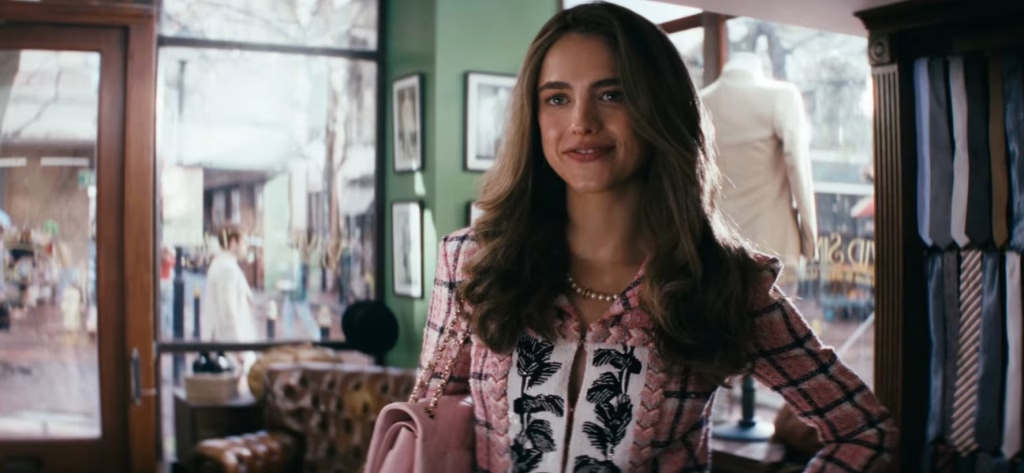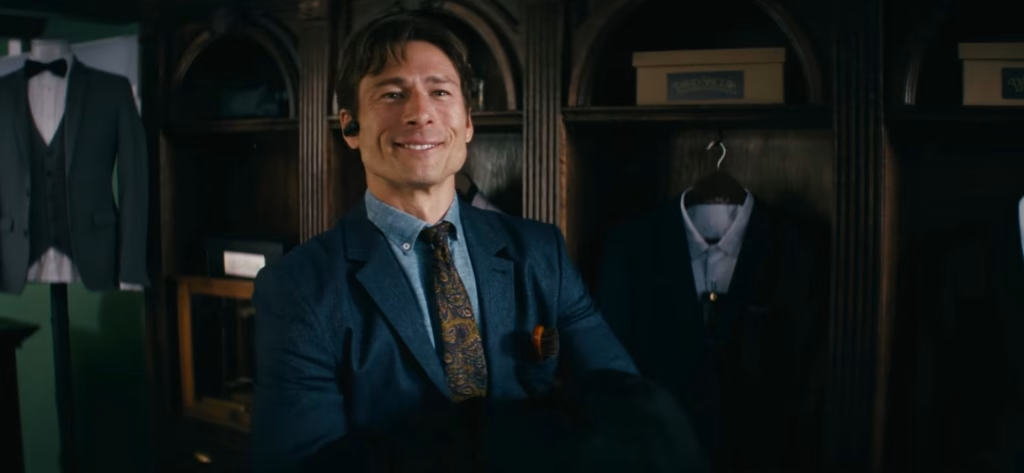From the director of the acclaimed Emily the Criminal comes a wickedly dark comedy that takes inheritance disputes to murderous extremes. How to Make a Killing reunites A24 with director John Patton Ford for a black comedy thriller inspired by the 1949 British classic Kind Hearts and Coronets. Glen Powell leads the ensemble cast as Becket Redfellow, a blue-collar man who discovers he’s the disowned son of phenomenally wealthy heirs and will stop at nothing to reclaim what he believes is rightfully his—even if it means eliminating seven family members who stand between him and a $28 billion fortune.
Hitting theaters exclusively on February 20, 2026, How to Make a Killing marks a significant departure from Glen Powell’s recent blockbuster roles while showcasing his versatility as Hollywood’s most in-demand leading man. Alongside Powell, Margaret Qualley brings her distinctive intensity to this tale of class warfare, deception, and deliciously imaginative murder schemes that promise to keep audiences guessing until the final frame.
Table of Contents
Glen Powell: From Hangman to Heir Apparent
Glen Powell has experienced a meteoric rise to Hollywood’s A-list over the past three years, transforming from a character actor into one of cinema’s most bankable leading men. Born October 21, 1988, in Austin, Texas, Powell began his acting career as a child, making his film debut at age 13 in Spy Kids 3-D: Game Over (2003) directed by Robert Rodriguez. For nearly two decades, Powell worked steadily in supporting roles across television and film, building his craft while waiting for his breakthrough moment.
| How to Make a Killing Production Details |
|---|
| Release Date: February 20, 2026 |
| Studio: A24, StudioCanal |
| Director: John Patton Ford |
| Screenplay: John Patton Ford |
| Producers: Graham Broadbent, Peter Czernin, Adam Friedlander |
| Lead Cast: Glen Powell as Becket Redfellow |
| Supporting Cast: Margaret Qualley, Ed Harris, Topher Grace, Jessica Henwick, Bill Camp, Zach Woods |
| Inspiration: Kind Hearts and Coronets (1949) |
| Former Title: Huntington, Rothchild |
That breakthrough arrived with Top Gun: Maverick (2022), where Powell portrayed Lieutenant Jake “Hangman” Seresin opposite Tom Cruise. The role almost didn’t happen—Powell initially auditioned for the part of Bradley “Rooster” Bradshaw, which went to Miles Teller. When offered Hangman instead, Powell hesitated because he viewed the character as underdeveloped. A personal call from Tom Cruise convinced Powell to accept the role, with Cruise offering him greater creative control over the character. The gamble paid off spectacularly. Top Gun: Maverick became the highest-grossing film of 2022, earning nearly $1.5 billion worldwide, and Powell’s portrayal of the cocky, talented pilot became the sequel’s breakout character.
Powell capitalized on his Top Gun momentum with a string of critically and commercially successful projects. He co-starred with Sydney Sweeney in the romantic comedy Anyone But You (2023), which became a surprise hit, grossing over $200 million globally and becoming the highest-grossing R-rated film of the year. The on-screen chemistry between Powell and Sweeney sparked widespread speculation about a possible off-screen romance, which they playfully encouraged during the promotional campaign to enhance audience interest.
In 2023, Powell reunited with director Richard Linklater for Hit Man, a dark comedy based on real events about a professor who poses as an assassin for a police department. Powell not only starred but co-wrote the screenplay with Linklater and co-produced the film. Netflix purchased the streaming rights, and Hit Man debuted in 2024 to rave reviews. Several critics praised Powell’s performance as a “genuine star-clinching turn,” with Sophie Butcher of Empire writing that Powell “announces himself as a movie star and a filmmaking force to be reckoned with.” His performance earned him a nomination for the Golden Globe Award for Best Actor in a Motion Picture – Musical or Comedy.
Powell followed Hit Man with Twisters (2024), the standalone sequel to the 1996 disaster film Twister. Playing Tyler Owens, a YouTube storm chaser with cowboy swagger, Powell anchored the summer blockbuster that earned over $300 million globally and became one of the top-grossing films of 2024. IndieWire’s David Ehrlich commended Powell for “churning pure charisma” in his performance. The film proved Powell could carry a major franchise release as the undisputed lead rather than sharing the spotlight with established stars.
In 2025, Powell expanded into television with Chad Powers, a comedy series for Hulu that he created, produced, and starred in. The show follows Russ Holiday’s attempt to stage a comeback in football by disguising himself with a fake identity. Stuart Heritage of The Guardian called Powell’s performance one of the “most magnetic and magical performances in memory.” Powell also starred in Edgar Wright’s adaptation of Stephen King’s thriller novel The Running Man, though the film underperformed at the box office during its opening weekend.
Despite recent setbacks, Powell remains one of Hollywood’s most sought-after talents. His forthcoming projects include the J.J. Abrams film Ghostwriter alongside Jenna Ortega, Emma Mackey, and Samuel L. Jackson. Powell recently relocated from Los Angeles back to his hometown of Austin, Texas, in 2024, maintaining his Texas roots despite his Hollywood success. He’s a licensed pilot, with Tom Cruise personally paying for Powell to attend flight school during Top Gun: Maverick production. Powell credits Chris Pratt’s breakout role in Guardians of the Galaxy (2014) with helping to shift Hollywood’s leading man archetypes from brooding intensity to “more silly and buoyant” energy, creating space for Powell’s own charismatic screen presence.
Margaret Qualley: The Substance of Stardom
Margaret Qualley has emerged as one of contemporary cinema’s most fearless performers, consistently choosing projects that challenge both her acting abilities and audience expectations. Born October 23, 1994, in Kalispell, Montana, Qualley is the daughter of actress Andie MacDowell and rancher Paul Qualley. Despite her famous parentage, Qualley has carved out her own distinctive path in Hollywood, deliberately avoiding being dismissed as a “nepo baby” by living independently as a minor and handpicking all of her projects.
Qualley’s journey to acting began with ballet. As a child, she trained extensively in classical ballet, attending the University of North Carolina School of the Arts boarding school near Asheville. At age 16, she participated in a summer workshop at the American Ballet Theatre in New York City, where she realized the physical and mental toll the art form was taking on her body and mind.
She gave up ballet as a potential career and briefly worked as a model to support herself in New York. At age 16, Qualley made her modeling debut during New York Fashion Week, walking for Alberta Ferretti. She modeled during Paris Fashion Week Spring/Summer 2012 for Valentino and Chanel, becoming a house ambassador for Chanel.

Qualley’s first on-screen appearance came in 2013 when she played a small part in Gia Coppola’s film Palo Alto. She happened to be on set visiting her then-boyfriend, Nat Wolff, when she received the role. In June 2013, she was cast as a series regular in the HBO television series The Leftovers, playing Jill Garvey for three seasons (2014-2017). The metaphysical drama about a rapture-like disappearance provided Qualley with crucial training in sustained character development across multiple seasons.
Qualley’s breakthrough into film came with a memorable role in Quentin Tarantino’s Once Upon a Time in Hollywood (2019), where she portrayed Pussycat, a hitchhiking hippie and member of the Manson Family. Despite minimal screen time, Qualley captivated audiences with her energetic, bewitching performance opposite Brad Pitt and Leonardo DiCaprio. From the moment she catches Pitt’s eye and delivers her brief but unforgettable performance, Qualley proved she could hold her own alongside cinematic legends while working under one of cinema’s most demanding directors. For the film, Qualley and the rest of the cast were nominated for a Screen Actors Guild Award for Outstanding Performance by a Cast in a Motion Picture.
In 2019, Qualley also portrayed actress and dancer Ann Reinking in the FX miniseries Fosse/Verdon, for which she received nominations for a Primetime Emmy Award for Outstanding Supporting Actress in a Limited Series or Movie and a Critics’ Choice Television Award for Best Supporting Actress in a Movie/Miniseries. Her dancing background proved invaluable in capturing Reinking’s distinctive movement style.
Qualley’s most acclaimed performance came in the Netflix drama miniseries Maid (2021), where she starred as Alex Russell, a young mother who struggles to provide for her child after fleeing an abusive relationship. The role showcased Qualley’s ability to convey vulnerability, strength, and determination in a nuanced portrayal of economic and domestic hardship. For her performance, she received nominations for the Golden Globe Award for Best Actress – Miniseries or Television Film and the Screen Actors Guild Award for Outstanding Performance by a Female Actor in a Miniseries or Television Movie. Notably, Qualley’s mother Andie MacDowell played her on-screen mother in the series, addressing “nepo baby” criticisms head-on by demonstrating their authentic chemistry.
In 2022, Qualley starred in Claire Denis’s Stars at Noon opposite Joe Alwyn, followed by a 2023 turn in the erotic thriller Sanctuary opposite Christopher Abbott, which she also executive produced. Her willingness to take risks with challenging material continued with appearances in director Yorgos Lanthimos’s films Poor Things (2023) alongside Emma Stone and Mark Ruffalo, and Kinds of Kindness (2024), where she played four different characters in three separate storylines. Both films premiered at the Cannes Film Festival.
In 2024, Qualley starred in Ethan Coen’s comedy road film Drive-Away Dolls opposite Geraldine Viswanathan, marking the first solo fiction film by one of the Coen brothers. The film follows a young lesbian woman who shamelessly flirts with her best friend while trying to outrun gangsters in a sultry adventure that showcased Qualley’s fearless comedic timing.
Qualley’s most talked-about 2024 performance came in Coralie Fargeat’s body horror film The Substance with Demi Moore and Dennis Quaid. In this provocative feminist horror film, which won the Best Screenplay award at the 77th Cannes Film Festival, Qualley plays Sue, a creature born from a futuristic experiment initiated by falling Hollywood fitness star Elisabeth Sparkle (portrayed by Demi Moore).
Qualley embodies a razor-sharp young woman willing to endanger her own matrix just to have fun, dazzle in society, and be loved by everyone. At times sexy, funny, or menacing, she effortlessly shifts from the tender, innocent expressions of a wide-eyed ingénue to the sly smile and piercing gaze of a schemer flirting with her monstrous side. Her performance earned her a second Golden Globe nomination, though she was surprisingly snubbed by the Academy Awards.
Qualley married musician and producer Jack Antonoff in August 2023 in Long Beach Island, New Jersey. Antonoff, frontman of the band Bleachers and frequent collaborator with artists including Taylor Swift, Lorde, and Lana Del Rey, inspired Del Rey’s song “Margaret,” which features Bleachers. Qualley told Harper’s Bazaar: “Before I met Jack…I never made a home at all. I didn’t care; I cared about movies. It’s really exciting now to be making a home and to have something to care for.”
John Patton Ford: The Director Behind Emily the Criminal
John Patton Ford brings Emmy-nominated director credentials to How to Make a Killing following his breakthrough feature Emily the Criminal (2022). Born December 30, 1981, in Sumter, South Carolina, Ford attended the University of South Carolina before earning his Master of Fine Arts from the American Film Institute (AFI Class of 2009). His AFI thesis film Patrol premiered at the 2010 Sundance Film Festival and was shortlisted for the Academy Award for Best Live Action Short Film.
Despite early success, Ford spent years struggling to secure financing for his first feature. After graduating from AFI, he accumulated hundreds of thousands of dollars in student debt while taking various jobs, including working for a catering company. He wrote scripts for Universal, Disney, and Sony while attempting to sell his own projects. Before finally getting the chance to direct Emily the Criminal, Ford had four other projects fall apart close to production. This period of financial struggle and professional frustration directly informed the themes explored in Emily the Criminal.
Ford’s screenplay for How to Make a Killing originally appeared on the 2014 Black List under the title Rothchild, landing at number five on that year’s list of best unproduced screenplays. Ford described his creative breakthrough with that script in an American Film Institute interview: “At this point, I was just so hungry to stop catering and have a job of any kind that I decided to try to write a script that I couldn’t necessarily see myself directing. Then I had this explosive idea for ‘Rothchild,’ and I didn’t worry about directing it and just focused on writing it.“
“I was just having fun, and it was such a huge lesson that if there’s some creative thing you have, just go do it. Don’t worry about execution. Just go write the thing that you’re enthusiastic about because if you are having fun writing it, chances are people will have fun reading it.”
In 2019, director Jon S. Baird signed on to direct the film with Shia LaBeouf and Mel Gibson attached to star. However, development stalled, and when the project resumed in March 2023, Ford took over directing duties himself. The film was retitled Huntington before receiving its final title How to Make a Killing shortly before the trailer release in November 2025.
Ford’s Emily the Criminal premiered at the 2022 Sundance Film Festival and starred Aubrey Plaza as a young woman saddled with student debt and locked out of the job market due to a criminal record who gets involved in a credit card scam.
The film received positive reviews from critics, with particular praise for its screenplay and Plaza’s performance. It earned four nominations at the 38th Independent Spirit Awards, including Best First Feature, with Ford winning Best First Screenplay. The film’s success came from Ford’s ability to grab audiences “really unapologetically and just take you on this ride, and to never really give you much of a choice but to watch it…to have that kind of a raw effect upon an audience.”
Ford mentions Jacques Audiard and Michael Mann as some of his biggest influences, citing their ability to create kinetic thrillers with strong social commentary. In May 2024, Legendary Television acquired the rights to adapt Emily the Criminal into a TV series, with Plaza and Ford serving as executive producers and Ford returning as director, though Plaza will not reprise her role.
The Plot: Pruning the Family Tree
How to Make a Killing follows Becket Redfellow (Glen Powell), the son of Mary, an heiress to the vast Redfellow estate who was disowned by the family when Becket was born. When Mary passes away, impoverished and alone, Becket decides to make good on her belief that he is destined for greatness, no matter how evil he might need to be to achieve it. Ruthlessly determined to get back what Mary always said was stolen from him, Becket hatches a murderous scheme to eliminate the seven Redfellow relatives who stand between him and his inheritance.
As Becket explains in the trailer: “There were seven of them—seven rich pricks between myself and $28 billion.” He ominously continues, “If I were to prune a few branches from the family tree…” as the trailer shows one such Redfellow being given the old heave-ho from a luxurious yacht. The film’s tagline “Heir today, gone tomorrow” perfectly captures the dark humor underlying Becket’s increasingly elaborate murder schemes.

The official synopsis reads: “Disowned at birth by his obscenely wealthy family, blue-collar Becket Redfellow will stop at nothing to reclaim his inheritance, no matter how many relatives stand in his way.” As the heirs fall one by one in a series of deliciously imaginative accidents, Becket appears pretty sure that money can indeed buy happiness. However, his increasingly high-risk pruning operation attracts a manhunt, forcing Becket to stay one step ahead of authorities while continuing his deadly ascent up the family tree.
The film explores themes of class warfare, entitlement, and the lengths people will go to secure what they believe they deserve. Becket’s blue-collar background contrasts sharply with the opulent lifestyle enjoyed by the Redfellow family, creating sympathy for his predicament even as his methods become increasingly ruthless. The moral ambiguity at the heart of the story asks audiences to question their own definitions of justice and desert—is Becket reclaiming what was stolen from him, or is he simply a murderer dressed in the clothes of righteousness?
The Ensemble Cast: Murder Most Elegant
Beyond Glen Powell’s central performance as Becket Redfellow and Margaret Qualley’s role as a socialite who becomes entangled in Becket’s schemes, How to Make a Killing features an impressive ensemble of character actors bringing the doomed Redfellow family and their associates to life.
Ed Harris, the acclaimed actor known for The Truman Show, Apollo 13, and Westworld, joins the cast in an undisclosed role that likely involves either one of the Redfellow relatives or an authority figure investigating the mounting deaths. Harris brings gravitas and intensity to every project, and his presence suggests that at least one character will provide serious opposition to Becket’s plans.
Topher Grace, who broke out in That ’70s Show before appearing in films like BlacKkKlansman and In Good Company, adds his trademark nervous energy to the cast. Grace excels at playing characters who are simultaneously privileged and insecure, making him perfect casting for a wealthy heir who discovers his tenuous grip on the family fortune.
Jessica Henwick, known for her roles in The Matrix Resurrections, Glass Onion: A Knives Out Mystery, and Game of Thrones, brings action credentials and dramatic range. Her inclusion suggests at least one Redfellow relative won’t go quietly when Becket comes calling.
Bill Camp, one of character acting’s most reliable performers with credits including The Queen’s Gambit, The Night Of, and Joker, typically plays working-class individuals with hidden depths. His casting hints at possible allies for Becket among the household staff or lower-level family associates.
Zach Woods, the comedy stalwart from Silicon Valley, The Office, and Avenue 5, provides comic relief with his specialty of playing anxious, neurotic characters who mask their intelligence behind social awkwardness. Woods likely portrays one of the less threatening Redfellow relatives, making his inevitable demise all the more darkly humorous.
Additional cast members include James Frecheville (Animal Kingdom), Raff Law (The Talented Mr. Ripley star Jude Law’s son making his own mark in Hollywood), and several supporting players who flesh out the world of extreme wealth that Becket seeks to infiltrate and dominate.
The cast was assembled by casting director Lucy Bevan, whose credits include Barbie, providing confidence that each actor has been precisely matched to their role in Becket’s elaborate schemes.
Inspiration from Kind Hearts and Coronets
How to Make a Killing draws direct inspiration from Kind Hearts and Coronets, the 1949 British black comedy directed by Robert Hamer that stands as one of Ealing Studios’ greatest triumphs. That film starred Dennis Price as Louis D’Ascoyne Mazzini, the son of a woman disowned by her aristocratic family for marrying out of her social class. After her death, a vengeful Louis decides to take the family’s dukedom by murdering the eight people ahead of him in the line of succession to the title.
The original film’s most celebrated element was Alec Guinness’s virtuosic performance playing all eight D’Ascoyne family members of varying ages and both genders, including the Duke, the Banker, the Parson, the General, the Admiral, Young Ascoyne D’Ascoyne, Young Henry, and Lady Agatha D’Ascoyne. Guinness created distinct characters largely through body language, posture, and subtle costume changes, with director Robert Hamer shooting mostly in long and medium shots that allowed each character to exist as their own person rather than obviously the same actor.
Kind Hearts and Coronets was loosely based on the novel Israel Rank: The Autobiography of a Criminal (1907) by Roy Horniman. The film’s title derives from a line in Alfred Tennyson’s poem “Lady Clara Vere de Vere”: “Kind hearts are more than coronets, and simple faith than Norman blood.” The poem concerns class tensions surrounding love between classes, a theme that runs throughout both the 1949 original and Ford’s contemporary reimagining.
The film historian Sarah Street identifies themes of sexual repression running through Kind Hearts and Coronets, shown with Louis’s relationship with the manipulative Sibella. The historian Ross McKibbin sees the film as a “sustained satire” in its portrayal of the upper classes, particularly through the intended absurdity of the D’Ascoyne family all being portrayed by Guinness. The British Film Institute describes Kind Hearts and Coronets as “less sentimental” than many other Ealing films, instead “unleashing transgressive nightmares, fables of subversive, maverick masculine obsession and action.”
When Kind Hearts and Coronets premiered in London on June 13, 1949, it received widespread critical acclaim. Price’s performance was appreciated by numerous critics, with The Monthly Film Bulletin considering he gave a “brilliant performance.” The film was nominated for the British Academy Film Award for Best British Film alongside Passport to Pimlico and Whisky Galore!, though it lost to The Third Man. The film screened as one of Britain’s entries to the 10th Venice International Film Festival, where William Kellner won an award for Best Production Design.
According to Michael Newton writing for the British Film Institute, Kind Hearts and Coronets has retained the high regard of film historians as one of the wickedly best black comedies ever made. Roger Ebert called it one of cinema’s great movies, praising its dry, droll, literate and cynical approach to murder most elegant. The film’s influence extends across seven decades of cinema, inspiring countless imitators but rarely equaled in its precise balance of dark comedy, social satire, and genuine suspense.
How to Make a Killing updates the premise for contemporary audiences while maintaining the original’s essential DNA. Ford reduces the number of victims from eight to seven, likely to tighten the narrative and increase the stakes with each death. The shift from British aristocracy to American billionaires reflects modern wealth disparities while maintaining the class warfare themes. Where Guinness played all the victims, Ford’s version presumably casts different actors for each Redfellow relative, allowing for more varied character dynamics and murder methods.
A24’s Black Comedy Pedigree
A24’s involvement in How to Make a Killing continues the studio’s remarkable track record with dark comedies and morally ambiguous protagonists. Since its founding in 2012, A24 has established itself as Hollywood’s premier distributor of challenging, auteur-driven independent films that push boundaries while finding commercial success.
The studio’s comedy credentials include The Lobster (2015), Yorgos Lanthimos’s absurdist romance where single people must find a mate within 45 days or be transformed into an animal; Swiss Army Man (2016), featuring Daniel Radcliffe as a flatulent corpse helping a stranded man survive on a deserted island; The Disaster Artist (2017), James Franco’s loving tribute to the worst movie ever made; Eighth Grade (2018), Bo Burnham’s cringe-comedy about adolescent social anxiety; and Uncut Gems (2019), the Safdie Brothers’ anxiety-inducing thriller about a jeweler’s gambling addiction.
More recently, A24 has distributed Everything Everywhere All at Once (2022), which won seven Academy Awards including Best Picture while balancing multiverse science fiction with family drama and absurdist comedy; The Whale (2022), Darren Aronofsky’s devastating portrait of a morbidly obese man seeking redemption; and Priscilla (2023), Sofia Coppola’s intimate examination of Priscilla Presley’s relationship with Elvis.
The studio’s willingness to champion films with morally complex protagonists makes it the perfect home for How to Make a Killing. A24 understands that audiences can simultaneously root for and be horrified by characters who commit terrible acts in pursuit of understandable goals. The studio’s marketing expertise at positioning challenging films for mainstream success while maintaining their artistic integrity suggests How to Make a Killing will receive the precise promotional campaign it needs to find its audience.
StudioCanal serves as the film’s primary financier and production partner. The French studio owns Kind Hearts and Coronets and actively sought to create a contemporary reimagining of the classic film. StudioCanal’s involvement ensures proper respect for the source material while providing substantial budget support for the production’s period-appropriate luxury settings and elaborate murder set pieces.
Producers Graham Broadbent and Peter Czernin bring extensive experience in British and international productions, with credits including In Bruges, The Best Exotic Marigold Hotel, and Brooklyn. Their involvement suggests How to Make a Killing will maintain the sophisticated wit and clever plotting essential to successful dark comedies. Adam Friedlander rounds out the producing team, with executive producers Rick Mischel and Fonda Snyder overseeing various production elements.
Production History and Development
The journey from Black List screenplay to theatrical release spans over a decade for How to Make a Killing. Ford wrote the original screenplay in 2014 under the title Rothchild, drawing inspiration from his own experiences with class disparity and economic struggle while working minimum-wage jobs to pay off film school debt. The script landed at number five on the 2014 Black List, Hollywood’s annual survey of the best unproduced screenplays as voted by film industry executives.
Despite the Black List recognition, Ford couldn’t secure financing to direct the film himself. In 2019, director Jon S. Baird (Stan & Ollie, Filth) signed on to helm the project with Shia LaBeouf and Mel Gibson attached to star. However, that iteration fell apart before reaching production, likely due to LaBeouf’s well-documented personal and legal troubles that made him uninsurable for major studio productions. Gibson’s involvement would have been controversial given his history of antisemitic remarks and domestic violence allegations, though his presence might have secured financing from certain international markets.
Development resumed in March 2023 when Ford successfully leveraged his Emily the Criminal success into an opportunity to direct How to Make a Killing himself. The film was retitled Huntington, though Ford never publicly explained the reasoning behind either title. In January 2024, Glen Powell was cast in the lead role as Becket Redfellow, instantly elevating the project’s profile given Powell’s rising star power following Top Gun: Maverick and Anyone But You. Margaret Qualley and Ed Harris joined in May 2024, with the remaining ensemble cast filling out through summer 2024.
Principal photography took place from mid-2024 through fall 2024, primarily shooting in locations that could double for extreme wealth—luxurious estates, yachts, private clubs, and other exclusive venues that communicate the Redfellow family’s obscene riches. The production maintained secrecy around specific murder methods, with Ford directing his cast to avoid spoiling the film’s most inventive death sequences during interviews and social media posts.
During post-production, Ford and A24 decided to change the title from Huntington to How to Make a Killing. Powell confirmed the title change during a November 2025 interview with The Hollywood Reporter: “There’s going to be a new title that we will probably be debuting here in the next few weeks. But the movie is fantastic, and John Patton Ford is a great filmmaker. I can’t wait for people to see it.” The new title more directly communicates the film’s black comedy tone while maintaining the inheritance subplot’s centrality to the plot.
Visual Style and Cinematography
While specific cinematographer credits haven’t been publicly announced, How to Make a Killing’s trailer showcases a sophisticated visual approach that balances elegance with danger. The cinematography emphasizes the contrast between Becket’s blue-collar origins and the Redfellow family’s opulent lifestyle through careful attention to costume design, production design, and color palette.
Becket’s early scenes feature muted, desaturated colors and practical locations—diners, modest apartments, working-class neighborhoods—establishing his economic circumstances. As he infiltrates the Redfellow world, the color palette shifts to richer, more saturated tones—deep reds, golds, royal blues—that communicate extreme wealth while also suggesting danger and passion. The murder sequences appear to blend elegant wide shots that showcase the luxurious settings with more intimate, suspenseful framing as Becket executes his plans.
Ford’s visual approach likely draws inspiration from both the original Kind Hearts and Coronets, which featured meticulously composed frames that emphasized the theatrical artificiality of British aristocracy, and contemporary thrillers like Knives Out (2019) that use classical mise-en-scène to create visually sumptuous murder mysteries. The trailer shows Becket in various disguises and social situations, suggesting the film employs costume changes and physical transformation as key storytelling elements.
Production designer credits remain unannounced, but the trailer reveals substantial location shooting aboard luxury yachts, in palatial estates with extensive grounds, and in exclusive social venues where the ultra-wealthy gather. These locations aren’t simply backdrops but active elements in Becket’s schemes—every chandelier, staircase, and decorative element potentially becomes a murder weapon in the wrong (or from Becket’s perspective, right) hands.
Release Strategy and Box Office Expectations
A24 will release How to Make a Killing exclusively in theaters on February 20, 2026, positioning the film during the typically slow late-winter period when few major releases compete for audience attention. This counter-programming strategy has proven successful for A24’s previous dark comedies, which thrive when audiences seek alternatives to franchise tentpoles and awards season holdovers.
The February release date places How to Make a Killing approximately two weeks before the Academy Awards ceremony, potentially allowing the film to capitalize on Oscar-related media attention while avoiding direct competition with nominated films still in theaters. The date also falls during the extended Presidents’ Day weekend in 2026, providing an extra day of potential ticket sales from the holiday Monday.
Box office expectations remain modest but achievable. A24’s recent dark comedies typically open in the $5-10 million range before building word-of-mouth and expanding to wider release. The Lobster earned $9 million domestically, Swiss Army Man grossed $4.9 million, and Uncut Gems reached $50 million through strong holds and positive buzz. How to Make a Killing benefits from Glen Powell’s proven box office appeal and Margaret Qualley’s rising profile, potentially pushing the opening weekend higher than typical A24 fare.
International distribution through StudioCanal provides additional revenue streams, with European markets particularly receptive to black comedies and sophisticated thrillers. The film’s inspiration from a British classic may generate curiosity in UK markets, where Kind Hearts and Coronets remains beloved. Asian markets have embraced several recent American dark comedies, though the film’s dialogue-heavy, culturally specific humor may limit its appeal in territories requiring subtitles or dubbing.
The theatrical release will be followed by premium video-on-demand availability approximately 45 days later, then streaming release through A24’s output deals with various platforms. Powell’s involvement should generate significant streaming interest given his loyal fanbase’s eagerness to consume his complete filmography across platforms.
Themes: Class Warfare and the American Dream Perverted
How to Make a Killing explores timely themes of wealth inequality, class resentment, and the corruption of the American Dream in an era of extreme income disparity. Becket Redfellow represents millions of Americans who feel economically left behind despite working hard and playing by the rules. His mother’s disownment for marrying outside her social class speaks to the rigid barriers that prevent upward mobility regardless of individual merit or effort.
The Redfellow family’s $28 billion fortune exists in obscene contrast to Becket’s blue-collar struggles, creating sympathy for his quest even as his methods become indefensible. The film asks uncomfortable questions about inheritance, desert, and justice: Did the Redfellow family earn their wealth through legitimate means? Does being born into privilege create any obligation to share that privilege with those less fortunate? At what point does reclaiming stolen property become theft itself?
Ford’s script likely examines how extreme wealth insulates the ultra-rich from consequences that would destroy ordinary people. The Redfellow relatives presumably commit legal, ethical, and moral violations with impunity because their money protects them from accountability. Becket’s murders can be read as vigilante justice against a class of people who exist above the law, even as they simultaneously represent his own moral degradation in pursuit of that same unaccountable wealth.
The film’s black comedy tone prevents it from becoming a heavy-handed polemic about wealth inequality. By treating Becket’s murder spree with dark humor rather than righteous anger, Ford invites audiences to laugh at the absurdity of a society where billion-dollar inheritances create life-or-death stakes. The murders themselves—falling off yachts, “accidental” poisonings, elaborate mishaps—parody the elaborate lifestyles of the ultra-rich while also serving as genuine thriller set pieces.
Ford’s own experiences with crushing student debt and economic precarity after film school directly inform the screenplay’s perspective on class warfare. In interviews about Emily the Criminal, Ford discussed how financial desperation can push otherwise moral people into criminal behavior when legitimate paths to success are systematically blocked. How to Make a Killing appears to explore similar territory through the lens of inheritance law and family obligation.
Marketing Campaign and Audience Positioning
A24’s marketing campaign for How to Make a Killing launched with a trailer release in late November 2025, generating immediate online buzz from Powell’s fanbase and A24’s devoted following. The trailer emphasizes the film’s darkly comic tone through Becket’s deadpan narration, elaborate murder scenarios scored to ironic music choices, and glimpses of Powell’s charismatic performance balancing charm with menace.
The tagline “Heir today, gone tomorrow” perfectly captures the film’s blend of wordplay humor and murderous intent, appearing prominently in poster designs and social media posts. Marketing materials emphasize the Kind Hearts and Coronets inspiration while positioning How to Make a Killing as a fresh take rather than a direct remake, attracting cinephiles familiar with the 1949 classic while not alienating younger audiences who’ve never heard of Alec Guinness.
Powell’s involvement drives a significant portion of the campaign, with the actor conducting extensive press interviews and appearing on talk shows to promote the film. His recent Saturday Night Live hosting debut in late 2025 provided additional visibility, with How to Make a Killing likely receiving mentions during the show’s promotional segments. Powell’s social media presence allows direct fan engagement, with behind-the-scenes content and co-star interactions building anticipation.
Margaret Qualley’s involvement attracts audiences who appreciated her work in The Substance and other recent acclaimed performances. Her fashion-forward red carpet appearances as a Chanel house ambassador generate aspirational media coverage that positions How to Make a Killing as sophisticated counter-programming to lowbrow comedies and action fare.
The ensemble cast enables targeted marketing to different demographic segments. Ed Harris’s presence attracts older viewers who remember his iconic performances, Topher Grace appeals to millennials who grew up with That ’70s Show, and Jessica Henwick brings fans of her genre work in The Matrix Resurrections and Game of Thrones. This multi-pronged approach expands the potential audience beyond A24’s typical art-house demographic.
Festival strategy remains unconfirmed, but How to Make a Killing could premiere at the Sundance Film Festival in January 2026, just weeks before its theatrical release. A Sundance premiere would mirror Emily the Criminal’s successful festival bow while generating critical buzz ahead of wide release. Alternatively, A24 might skip festivals entirely and rely on preview screenings and social media buzz to build word-of-mouth.
Critical Reception and Awards Potential
Early reactions from test screenings reportedly praise Powell’s performance as his most complex and darkly comic to date, suggesting the actor successfully balances audience sympathy with moral revulsion at Becket’s actions. Qualley’s role allegedly provides the film’s moral center, with her character forcing Becket to confront the human cost of his inheritance schemes.
Ford’s direction receives particular praise for maintaining tonal consistency across the film’s most outrageous moments. The challenge in any black comedy lies in balancing humor with genuine stakes—if the deaths are too funny, audiences stop caring about the victims; if they’re too serious, the comedy falls flat. Early buzz suggests Ford navigates this tightrope successfully, creating murder sequences that are simultaneously hilarious and horrifying.
The screenplay’s wit and intelligence position How to Make a Killing as potential awards contender in screenplay categories at the Independent Spirit Awards and Writers Guild Awards. Ford’s previous Best First Screenplay win at the Spirit Awards demonstrates the voting body’s appreciation for his writing, and How to Make a Killing’s sharper satirical edge may resonate with voters looking to reward topical commentary on wealth inequality.
Powell’s performance could generate conversation for Best Actor nominations at the Golden Globes’ Musical or Comedy category, where he was previously nominated for Hit Man. The Academy of Motion Picture Arts and Sciences rarely nominates performances in dark comedies for major acting awards, but Powell’s rising profile and the role’s complexity might break through in a year with relatively weak Best Actor contenders.
Production categories including Production Design, Costume Design, and Original Screenplay present the most likely paths to mainstream awards recognition. The film’s elaborate period-appropriate luxury settings and Becket’s various disguises provide strong technical showcases that could impress craft category voters.
Glen Powell’s Career Trajectory
How to Make a Killing arrives at a crucial inflection point in Glen Powell’s career. After establishing himself as a bankable leading man through blockbusters like Top Gun: Maverick and Twisters, Powell must now prove he can deliver in more challenging, character-driven material that showcases his range beyond charismatic charm.
The role of Becket Redfellow represents Powell’s most morally ambiguous protagonist to date. While Hit Man featured a sympathetic professor posing as a hitman, that character never actually killed anyone. Becket actively murders seven family members, forcing Powell to maintain audience sympathy for an actual serial killer. This challenge separates movie stars from true actors—can Powell make audiences root for a murderer?
Powell’s willingness to take this risk demonstrates artistic ambition beyond simply chasing paycheck roles. He could have leveraged his Top Gun success into more blockbuster sequels and franchise entries, but instead he’s balancing commercial projects with independent films that stretch his abilities. This career strategy mirrors Matthew McConaughey’s “McConaissance” transformation from romantic comedy star to serious dramatic actor through strategic role selection.
The actor’s upcoming slate suggests continued diversity. Beyond How to Make a Killing, Powell stars in J.J. Abrams’s Ghostwriter, a likely genre-blending thriller that combines Abrams’s mystery box storytelling with Powell’s leading man credentials. The involvement of Jenna Ortega, Emma Mackey, and Samuel L. Jackson suggests an ensemble piece that allows Powell to play off varied acting styles and personalities.
Powell’s return to Texas and investment in his home state’s film industry suggests long-term thinking about career longevity beyond Hollywood’s typical boom-and-bust cycles. By maintaining connections to his Austin roots, Powell positions himself as the rare actor who can work in studio tentpoles, independent films, and regional productions without sacrificing artistic credibility or commercial viability.
The Future of Dark Comedies
How to Make a Killing arrives during a renaissance for sophisticated dark comedies that trust audiences to appreciate morally complex narratives. The success of films like Knives Out, The Menu, Triangle of Sadness, and Glass Onion: A Knives Out Mystery demonstrates that audiences hungry for clever plotting, biting social commentary, and stars they trust to deliver will turn up for original stories that challenge genre conventions.
The film’s exploration of class warfare through the inheritance thriller format provides a template for how dark comedies can address serious societal issues without becoming preachy or didactic. By wrapping wealth inequality commentary inside entertaining murder schemes, Ford creates a Trojan horse that delivers social criticism alongside thrills and laughs.
The streaming era initially seemed to threaten theatrical dark comedies, with many studios relegating mid-budget adult dramas and comedies to direct-to-streaming releases. However, A24’s consistent theatrical success with challenging material has proven that distinctive voices telling original stories can still attract theatrical audiences willing to leave their homes for experiences unavailable on small screens.
How to Make a Killing’s February 2026 release will test whether audiences maintain their appetite for dark comedies featuring unlikable protagonists after several years of similar films. The genre risks oversaturation if every studio produces eat-the-rich thrillers with interchangeable protagonists. However, Powell’s star power, Ford’s proven directorial chops, and the Kind Hearts and Coronets pedigree distinguish this project from cheaper imitators.
Heir Raising Entertainment
How to Make a Killing promises to deliver the rare combination of star power, directorial vision, and timely social commentary that defines the best dark comedies. Glen Powell steps into his most challenging role yet, playing a blue-collar Machiavelli whose quest to reclaim his stolen inheritance requires murdering his way through seven relatives who never earned the privilege they were born into. Margaret Qualley provides the moral complications that prevent the film from becoming a simple revenge fantasy, while director John Patton Ford channels the spirit of Kind Hearts and Coronets for contemporary audiences grappling with unprecedented wealth inequality.

The film’s February 20, 2026, theatrical release through A24 positions it as counter-programming to big-budget franchise entries, offering audiences craving sophisticated wit and genuine stakes an alternative to superhero spectacles and animated sequels. Whether Becket succeeds in claiming his $28 billion inheritance—and whether audiences ultimately root for or against his murderous schemes—remains to be seen when How to Make a Killing reaches theaters.
One thing is certain: Glen Powell and Margaret Qualley have created something special with director John Patton Ford, a darkly comic thriller that asks uncomfortable questions about wealth, privilege, and justice while delivering the elegant murders and clever plotting that made Kind Hearts and Coronets a beloved classic. As the tagline promises, in the world of the Redfellow family fortune, you’re either an heir today or gone tomorrow.
Read More: Far Cry Series Ordered by FX: Noah Hawley and Rob McElhenney Team Up for Ubisoft Anthology
FAQs
When does How to Make a Killing release in theaters?
How to Make a Killing releases exclusively in theaters on February 20, 2026, through A24 and StudioCanal. The late February date positions the film during a typically slow box office period, allowing the dark comedy thriller to build word-of-mouth without competing against major blockbusters.
What is Glen Powell’s role in How to Make a Killing?
Glen Powell stars as Becket Redfellow, a blue-collar man who was disowned at birth by his phenomenally wealthy family. When his mother dies impoverished, Becket hatches a murderous scheme to eliminate seven Redfellow relatives standing between him and a $28 billion inheritance. The role represents Powell’s most morally complex protagonist to date.
How is How to Make a Killing connected to Kind Hearts and Coronets?
How to Make a Killing draws direct inspiration from the 1949 British black comedy Kind Hearts and Coronets directed by Robert Hamer. Both films follow disowned heirs who murder their way through aristocratic families to claim inheritances. The original featured Alec Guinness playing eight different family members, while Ford’s contemporary reimagining reduces the victim count to seven and updates the setting from British aristocracy to American billionaires.
What other actors star alongside Glen Powell in How to Make a Killing?
Margaret Qualley plays a socialite who becomes entangled in Becket’s schemes, while Ed Harris, Topher Grace, Jessica Henwick, Bill Camp, and Zach Woods round out the ensemble cast. Director John Patton Ford assembled the cast with help from Lucy Bevan, the casting director behind Barbie.
Who directed How to Make a Killing?
John Patton Ford wrote and directed How to Make a Killing as his second feature film following Emily the Criminal (2022). Ford’s screenplay originally appeared on the 2014 Black List under the title Rothchild before being retitled Huntington and finally How to Make a Killing. Ford won the Independent Spirit Award for Best First Screenplay for Emily the Criminal.








